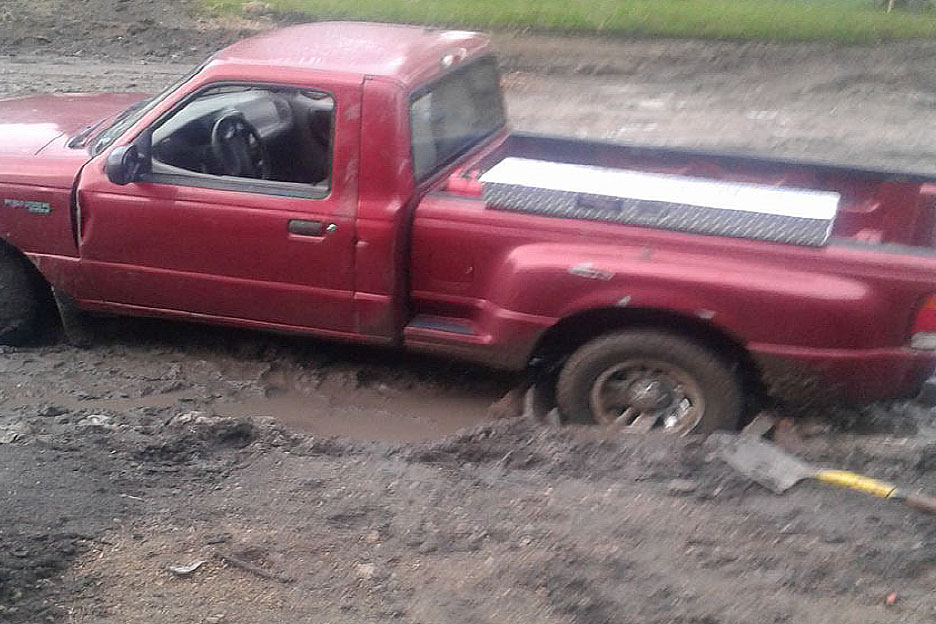Have you ever gotten your vehicle stuck in the mud? Let’s just say, it’s an interesting experience. Getting your vehicle out of the muddy situation that you got yourself in can be considered part art, part science, and it’s all about the ability to gain traction. If you get yourself in this situation again, here are 7 steps to remember on what to do to get your vehicle out of the mud:
-
Get out of the vehicle
We can first start by reducing the amount of weight of the vehicle to help keep your vehicle from sinking deeper into the mud. If you have anyone else in the vehicle, everyone should exit the vehicle and get to a safe distance away from the vehicle. If you are able to reduce weight by removing items from the vehicle and placing them in a safe location that would be advisable.
Keep your cool and remain calm, it’s time to determine how deeply entrenched your wheels are in the mud. You have to see if it’s just one, or are more wheels stuck? It might not be a difficult situation; you might be able to free your vehicle quickly.
-
Time to hit the mud and dig in!
It’s time to introduce your knees to the ground and scoop as much mud from the area directly in front of the tires; if you have a shovel, then you’re ahead of the game. The objective is to make the mud rut less steep so that your vehicle can climb out.
-
Let’s give it shot approach
Let’s make sure that your front tires are pointing straight by turning your steering wheel until they are straight. If your vehicle has an automatic transmission, you’ll want to put it into its lower gear; if you have a manual transmission (stick shift), you’ll want to put it in 2nd or 3rd and release the clutch. You’ll want to accelerate slowly, using the weight of the vehicle to get traction.
-
Do not give into pushing the pedal to the floor…Do not spin your tires!!!
If that failed to get you out of the mud, your gut might be telling you to press down on that gas pedal and accelerate. You must avoid doing this no matter what because it will only make the situation worse. Spinning your tires will not help you get your vehicle free from the mud, but you’ll lose traction due to the spinning tires and end up digging yourself even deeper in the mud.
-
Let’s attempt to get some traction
If your tires and axles are too deep in the mud, this is assuming that you have the jack that came with the vehicle or you carry a better jack, use it to attempt to lift the tires up a bit, enough to get a floor mat or cardboard under and in front of the tires. The top edge of the mat needs to be placed under the stuck tire, with the rest of the mat in front of the tire.
If you are unfortunate to have either of the above-mentioned items, check your vehicle for a blanket, use your clothing, or find some wood in the immediate area. The goal is to find items that will create traction so your vehicle will be able to pull forward out and over the muddy area.
After getting muddy, sweaty and maybe a little bloody, get back into your vehicle, and try to slowly accelerate. If this attempt to getting free of the mud works, get back on the road and don’t look back!
-
Let’s get some air out of those tires
If all else failed, try step 5 again, this time, let out some air from your tires first. By letting some of the air out of the tires you’d be increasing the surface area of your tires. Then dig the areas around the tires out again and put the floor mat, clothing or whatever you were using before back into place. Get back into the vehicle and carefully accelerate until you get traction and can move forward.
After getting your vehicle freed from the muddy mess it’s best if you re-inflate your tires before getting back on the road.
-
If the other steps have failed there are always Tow Straps
If you’re still stuck in the mud after attempting our tips, a tow strap will do the trick and save the day. Do you have any knowledge about pulling a vehicle with a tow strap?
If you’ve lived on a dirt road or on a good piece of property, you probably have some idea on how to use tow straps. If you do not, it’s a great skill to learn and master, if you’re in this situation, where you get your vehicle stuck in the mud, it could save you some time and effort as well as money. Educating yourself in how to pull a vehicle with a tow strap is not at all difficult as all, as long as you have a tow strap, a second vehicle, and a driver who is willing to give you a helping hand.
Tow straps are very helpful to keep in your vehicle just in case you ever need the piece of equipment. Tow straps are made of very strong nylon strands with either hooks that are sown into each end or solid loops at each end. Tow straps are lightweight and we would highly recommend that you have a tow strap in your vehicle’s emergency kit.
First, Attach the tow trap hook or loop to the rear of the vehicle that will be pulling the stuck vehicle, attach the strap to the rear trailer hitch or frame of the pulling vehicle. When attaching the straps, make sure they are not rubbing against anything sharp on the vehicle that could damage them.
Double check to ensure that the tow straps are properly secured and attached to the mount before you continue.
Secondly, find a solid area under the rear or front bumper of the vehicle that is stuck in the mud and attached the other end of the tow strap. Be sure that you have both ends of the tow strap secured correctly and that there are drivers in both vehicles. You must put your vehicle, and the vehicle being towed into drive or first gear, with the parking brake off.
The person driving the towing vehicle should gradually move forward to make sure that the tow strap is fully tight with no slack. At this point, you are ready to get the job done.
Theoretically, that is how you would pull a vehicle out with a tow strap. Once the vehicle is freed, you’ll need to drive the vehicle carefully and give your tires time to get rid of the excess mud and debris before traveling in full speed. Riggs Roadside crew members would highly recommend that you take your vehicle to get thoroughly cleaned and to have your brakes inspected by your mechanic.
Remember! Never attach the Tow Strap to something other than a hitch or tow hook. If you attach the tow strap to the bumper, axle or steering rods it could cause damage to the vehicle.

